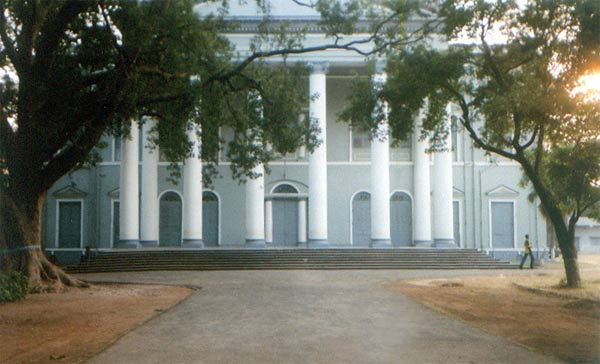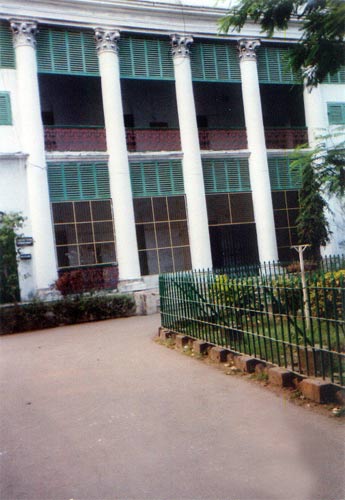Archaeological Sites
Sreerampore College


In the town, among many historical places, it will certainly be memorable to visit the lush green self contained sylvan complex of the historical institution Sreerampore College which has produced a number of stalwarts from all over the world. The campus has excellent buildings, residential complex, library, museum, church, students’ hostels and Guest House.
It is indeed always interesting and full of curiosity to discover the marvelous architecture of the college buildings, the erected huge and magnificent pillars which depicts the magnanimity of its own because it’s a wonderful experience to see the graceful main college building, raised by Sir William Carey and his colleagues in 1818, and surprisingly his first home was in Sreerampore, beside the broad Hoogly River. In 1827, the college was recognised as the first modern university in Asia.
The beginning of the nineteenth century is considered the most significant period in the history of Sreerampore, as during this period only the three European Baptist Missionaries –William Carey, Joshua Marshman and William Ward arrived, popularly known as ‘The Sreerampore trio’. They were actually responsible for the renaissance of Sreerampore. Though they came chiefly to preach Christianity, but they dedicated themselves to the services of the ailing and distressed people in and around the town. They spread the values of education and tried to reform and reconstruct the society.
Sreerampore College, the oldest institution to impart western education in India is a living memorial to William Carey, Joshua Marshman and William Ward. The founders had to bear the cost for the construction of the massive college building from their hard earned money, which was then estimated to be approximately Rs. 1, 50, 000/-, because Carey and his fellow associates felt the need to establish an institution that can be made accessible to all. But, such a Hindu college offering secular education at that time was exclusively meant for a few students from affluent upper class families.
It is said that Carey established the first Botanical Garden here, where afterwards the missionaries constructed and started running the Sreerampore College. The first Bengali language newspaper was published from a printing press, also established by Sir William Carey.
One has to spend several hours to explore the surrounding area. It is not unusual to see a group of boys playing football on the college field with full enthusiasm.
This institution is known to be the only college which conducts the classes of Theology and has the status of the deemed university. The academic administration of all the theological colleges affiliated with it is controlled by the senate of Sreerampore College (University). The College holds the power to confer degree in Theology.
Sources say, till date it remains the only institution in India where religion, arts and secular subjects are taught simultaneously.
The class rooms
A short walk to the cemetery could enable one to see committed and keen students from north eastern region of India.
The ex-speaker of Loksabha Mr. P. A. Sangma also happens to be an ex-student of the college. The Hindu saint Paramahansa Yogananda and (late) Swami Gukulananda, former Secretary of Ramakrishna Mission (Delhi) were also alumni of this college.
It may be a wonderful experience to get a lot of valuable information by spending time and talking to the non-teaching staff staying inside the college campus and students of the college who prefer to stay back even during vacations. It may be serene to visit a few class rooms, museum and the Indian church. Some of the very old working staffs seem to have knowledge of Carey’s work in India as great as anyone’s. It is said that initially the college commenced with 37 students only and the classes were held at the missionary building. The design of the building was thought by Major Wickedie and later Lord Hastings approved it. Slowly and gradually the college building took its graceful look by gifts and help rendered to them.
The king of Denmark gifted the front iron gate and two beautiful staircases. In 1822, it was possible to complete the two storied building, the majestic pillars and the impressive portico on the west bank of the river Hoogli covering almost seven acres of land as a gift of the Danish Government. Then the classes were shifted to the college building and the mission library was set up on the huge ground floor.
Reportedly an English scholar of science John Mack soon joined the ‘Sreerampore trio’. Together they worked with great harmony. During 1823; the college was hit hard by two great calamities – the devastating floods of Sreerampore and the sudden death of William Ward. The college started facing acute financial problem. In 1826 Joshua Marshman went to the King of Denmark to seek help. The king granted a Royal Charter in 1827 empowering the college to confer degrees. This is how; it became the first institution in Asia to grant degrees. The power conferred by the Royal Charter was used by the College for the first time in 1915 when three students of the College were conferred the degree of Bachelor of Divinity.
The college got the greatest shock at the death of William Carey on 8th July 1834. After this, the college suffered due to severe financial crisis.
The size of Mrs. Hannah Marshman’s chair is astonishing– which seems larger than those of her male colleagues. She was known as the “Mother of Sreerampore”. Hannah Marshman was the first woman missionary to India. The memorials of Carey, the Marshman and the Wards can be read at their graves.
The institution is vitally important for the development of education in India, but it needs to be looked after and valued. It is a challenge to keep the relevance of theological teaching for the needs of the society today. Although the institution of Sreeampore, steeped by tradition, but has many hindrances to overcome. It is also a strategic place for the ongoing education of Christian leaders in the Indian church of today and tomorrow.
The modern period of the history of Serampore College began in 1946 and with the Independence of India in 1947. Sreerampore College, throughout its existence, has been following the ideals of its founders who preached: ‘Expect great things from God, Attempt great things for God’.
In a country like India, this is high time that the college needs improvement in the facilities, also demand maintenance of the old buildings, and also adequate financial support as the cost of living of staff is quite enormous.
Dr. Lalchungnunga is the present Principal of Sreerampore College. He is a native of Mizoram. He became Principal at Sreerampore College in 1999 after several years of university instruction and missionary work in Delhi.
It is indeed a wonderful opportunity for everyone to visit this exciting place.




